1995 GMC SIERRA battery
[x] Cancel search: batteryPage 226 of 488
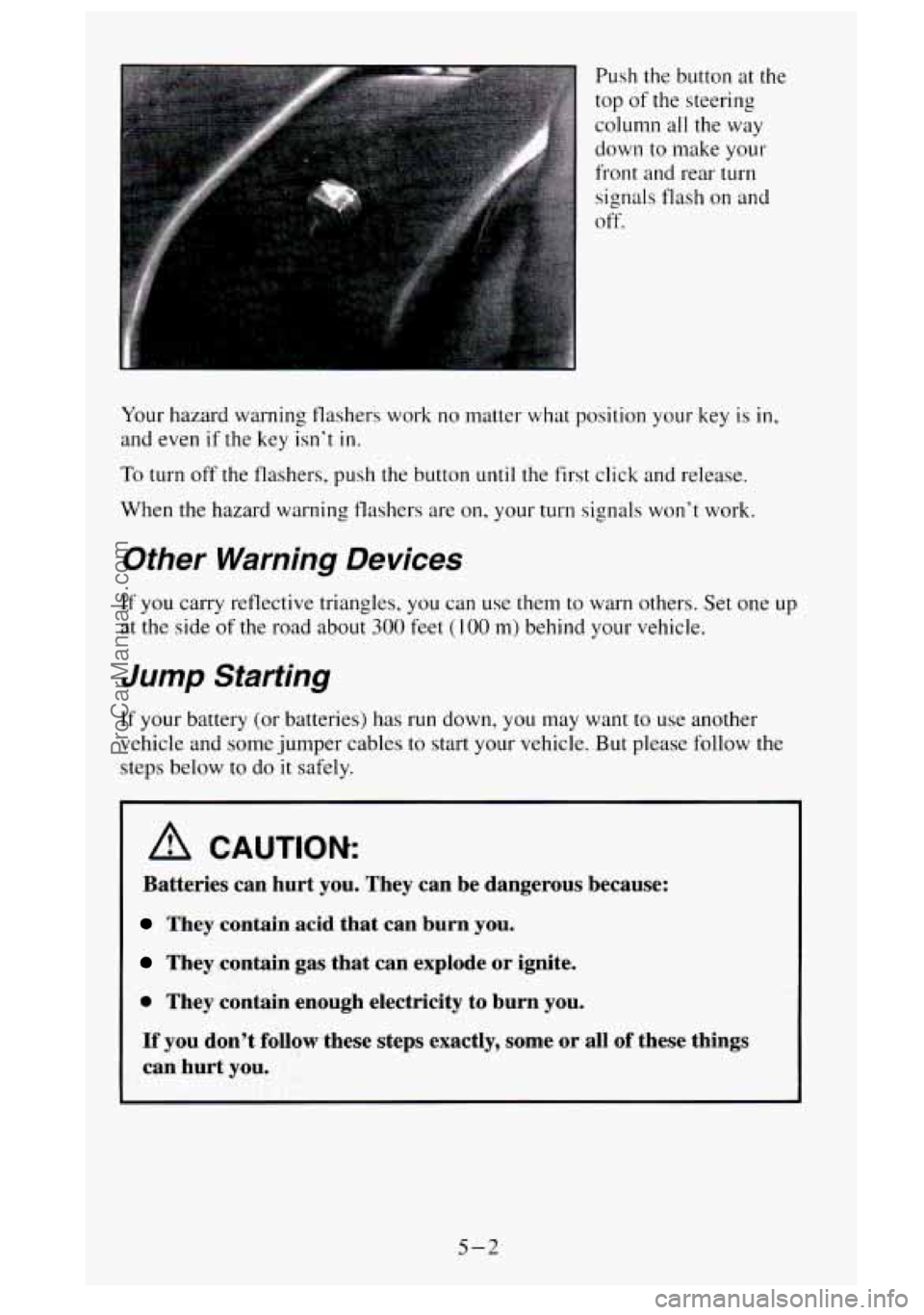
Push the button at the
top of the steering
column all the way
down to make
your
front and rear turn
signals flash on and
off.
Your hazard warning flashers work no matter what position your key is in,
and even if the key isn’t in.
To turn off the flashers, push the button until the first click and release.
When the hazard warning flashers are on, your turn signals won’t work.
Other Warning Devices
If you carry reflective triangles, you can use them to warn others. Set one up
at the side of the road about
300 feet (100 m) behind your vehicle.
Jump Starting
If your battery (or batteries) has run down, you may want to use another
vehicle and some jumper cables
to start your vehicle. But please follow the
steps below to do it safely.
A CAUTION:
Batteries can hurt you. They can be dangerous because:
They contain acid that can burn you.
They contain gas that can explode or ignite.
0 They contain enough electricity to burn you.
If you don’t follow these steps exactly, some or all of these things
can hurt you.
5-2
ProCarManuals.com
Page 227 of 488
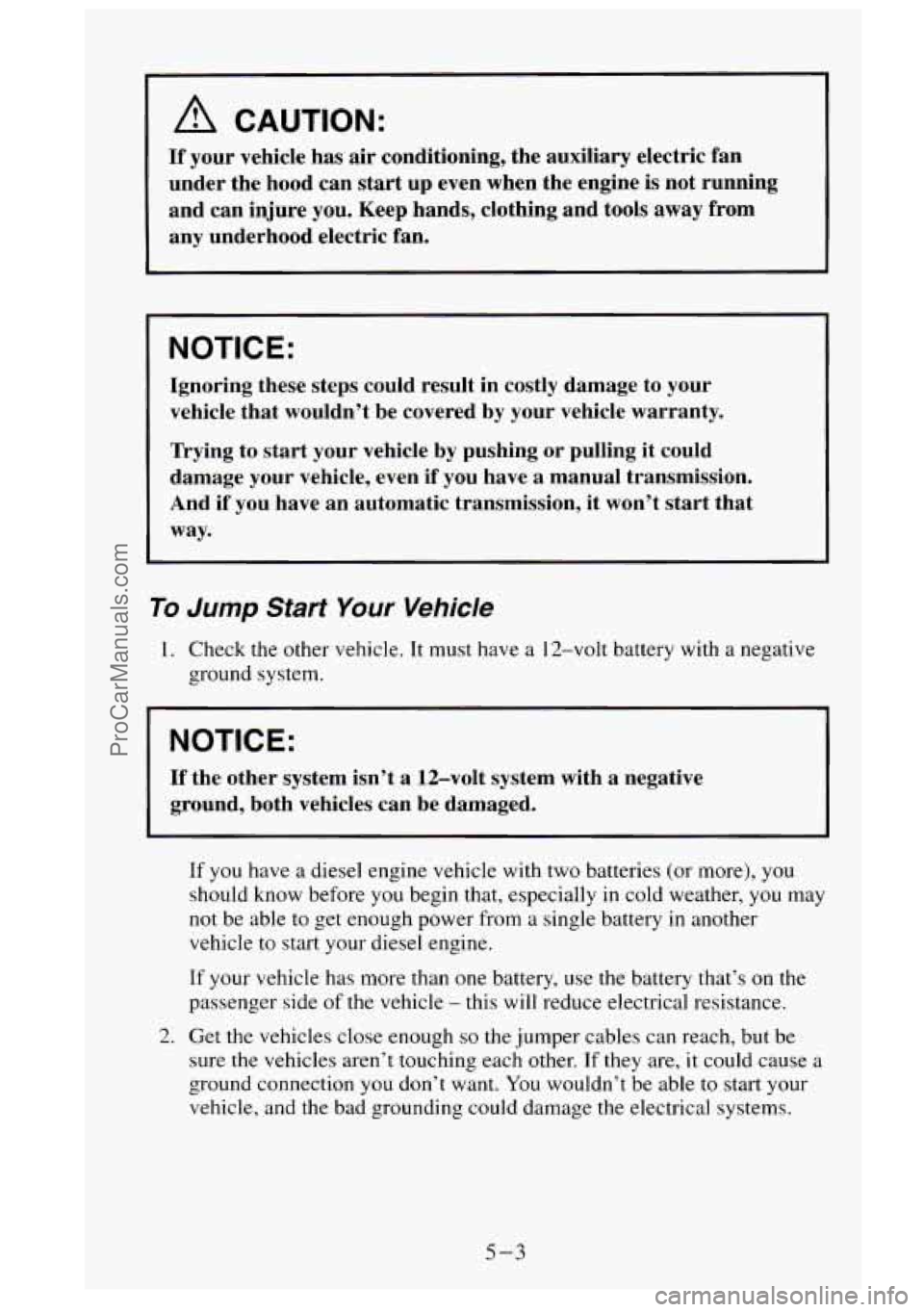
A CAUTION:
If your vehicle has air conditioning, the auxiliary electric fan
under the hood can
start up even when the engine is not running
and can injure you. Keep hands, clothing and
tools away from
any underhood electric fan.
-
NOTICE:
Ignoring these steps could result in costly damage to your
vehicle that wouldn’t be covered by your vehicle warranty.
Trying to start your vehicle by pushing or pulling it could
damage your vehicle, even if you have a manual transmission.
And if you have an automatic transmission,
it won’t start that
way.
To Jump Start Your Vehicle
1. Check the other vehicle. It must have a 12-volt battery with a negative
ground system.
NOTICE:
If the other system isn’t a 12-volt system with a negative
ground, both vehicles can be damaged.
If you have a diesel engine vehicle with two batteries (or more), you
should know before you begin that, especially in cold weather, you may
not be able to get enough power from a single battery
in another
vehicle to start your diesel engine.
If your vehicle has more than one battery, use the battery that’s on the
passenger side
of the vehicle - this will reduce electrical resistance.
2. Get the vehicles close enough so the jumper cables can reach, but be
sure the vehicles aren’t touching each other.
If they are, it could cause a
ground connection you don’t want.
You wouldn’t be able to start your
vehicle, and the bad grounding could damage
the electrical systems.
5-3
ProCarManuals.com
Page 228 of 488
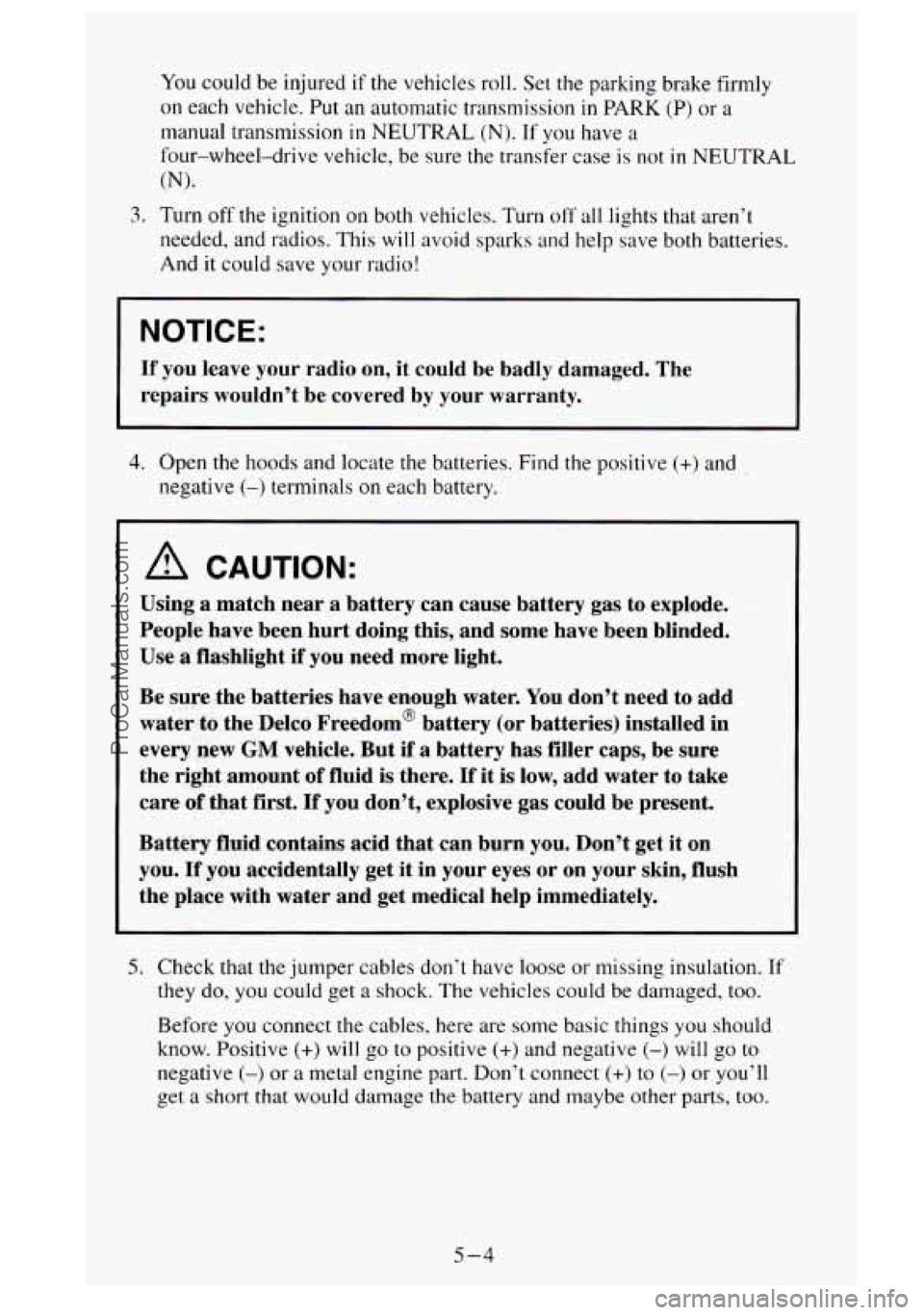
You could be injured if the vehicles roll. Set the parking brake firmly
on each vehicle. Put an automatic transmission in PARK (P) or a
manual transmission in NEUTRAL (N). If you have a
four-wheel-drive vehicle, be sure the transfer case is not in NEUTRAL
(N).
3. Turn off the ignition on both vehicles. Turn off all lights that aren’t
needed, and radios. This
will avoid sparks and help save both batteries.
And it could save your radio!
NOTICE:
If you leave your radio on, it could be badly damaged. The
repairs wouldn’t be covered by your warranty.
4. Open the hoods and locate the batteries. Find the positive (+) and
negative
(-) terminals on each battery.
A CAUTION:
Using a match near a battery can cause battery gas to explode.
People have been hurt doing this, and some have been blinded.
Use
a flashlight if you need more light.
Be sure the batteries have enough
water. You don’t need to add
water to the Delco Freedom@ battery (or batteries) installed in
every new
GM vehicle. But if a battery has filler caps, be sure
the right amount of fluid is there.
If it is low, add water to take
care
of that first. If you don’t, explosive gas could be present.
Battery fluid contains acid that can burn you. Don’t get
it on
you.
ff you accidentally get it in your eyes or on your skin, flush
the place with water and get medical help immediately.
5. Check that the jumper cables don’t have loose or missing insulation. If
they do,
you could get a shock. The vehicles could be damaged, too.
Before you connect the cables, here are some basic things you should
know. Positive
(+) will go to positive (+) and negative (-) will go to
negative
(-) or a metal engine part. Don’t connect (+) to (-) or you’ll
get
a short that would damage the battery and maybe other parts, too.
5-4
ProCarManuals.com
Page 229 of 488
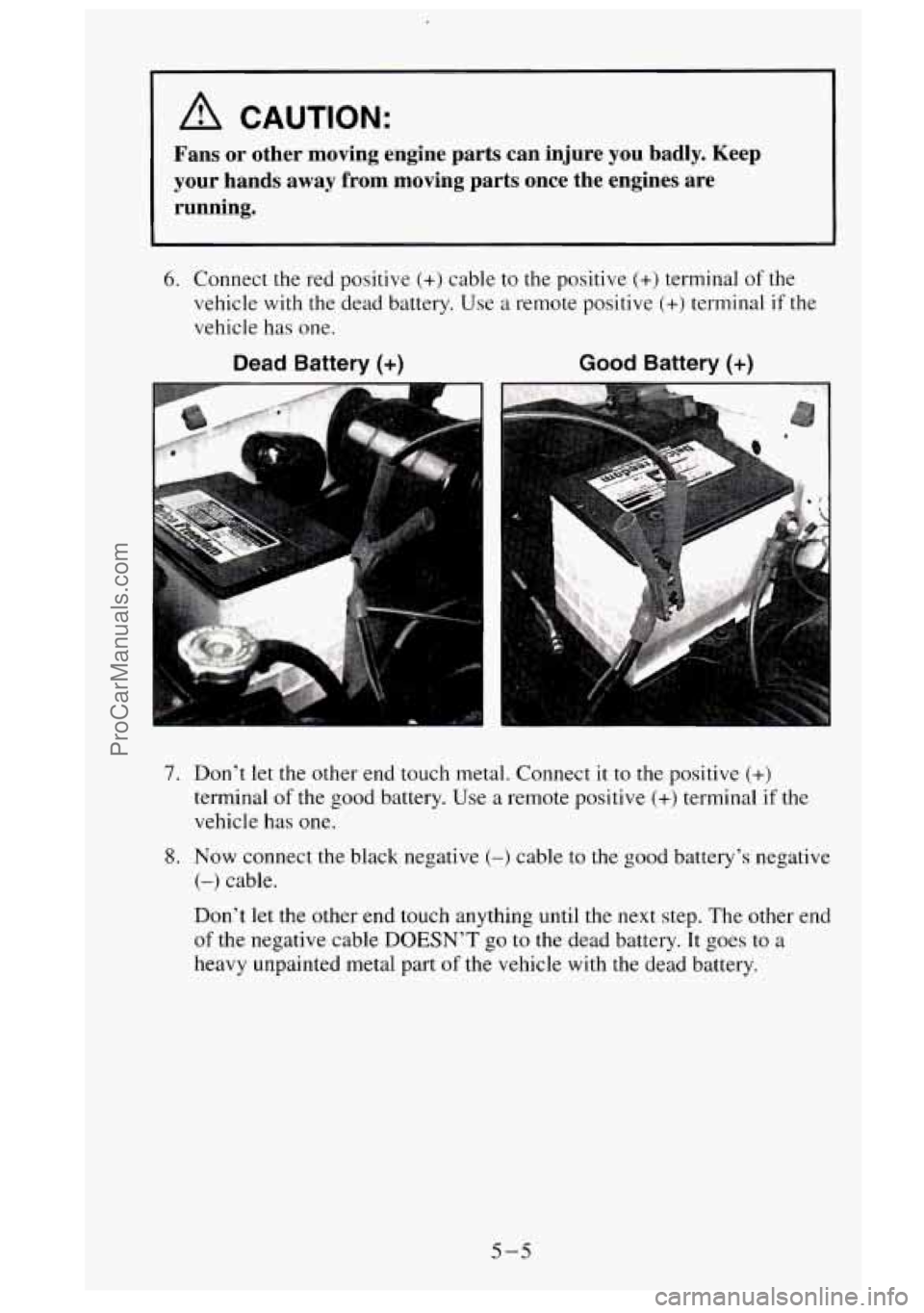
A CAUTION:
Fans or other moving engine parts can injure you badly. Keep
your hands away from moving parts once the engines are running.
6. Connect the red positive (+) cable to the positive (+) terminal of the
vehicle with the dead battery. Use a remote positive
(+) terminal if the
vehicle has one.
Dead Battery (+) Good Battery (+)
c
7. Don’t let the other end touch metal. Connect it to the positive (+)
terminal of the good battery. Use a remote positive (+) terminal if the
vehicle has one.
8. Now connect the black negative (-) cable to the good battery’s negative
(-) cable.
Don‘t
let the other end touch anything until the next step. The other end
of the negative cable DOESN’T go to the dead battery. It goes to a
heavy unpainted metal part of the vehicle with the dead battery.
5-5
ProCarManuals.com
Page 230 of 488
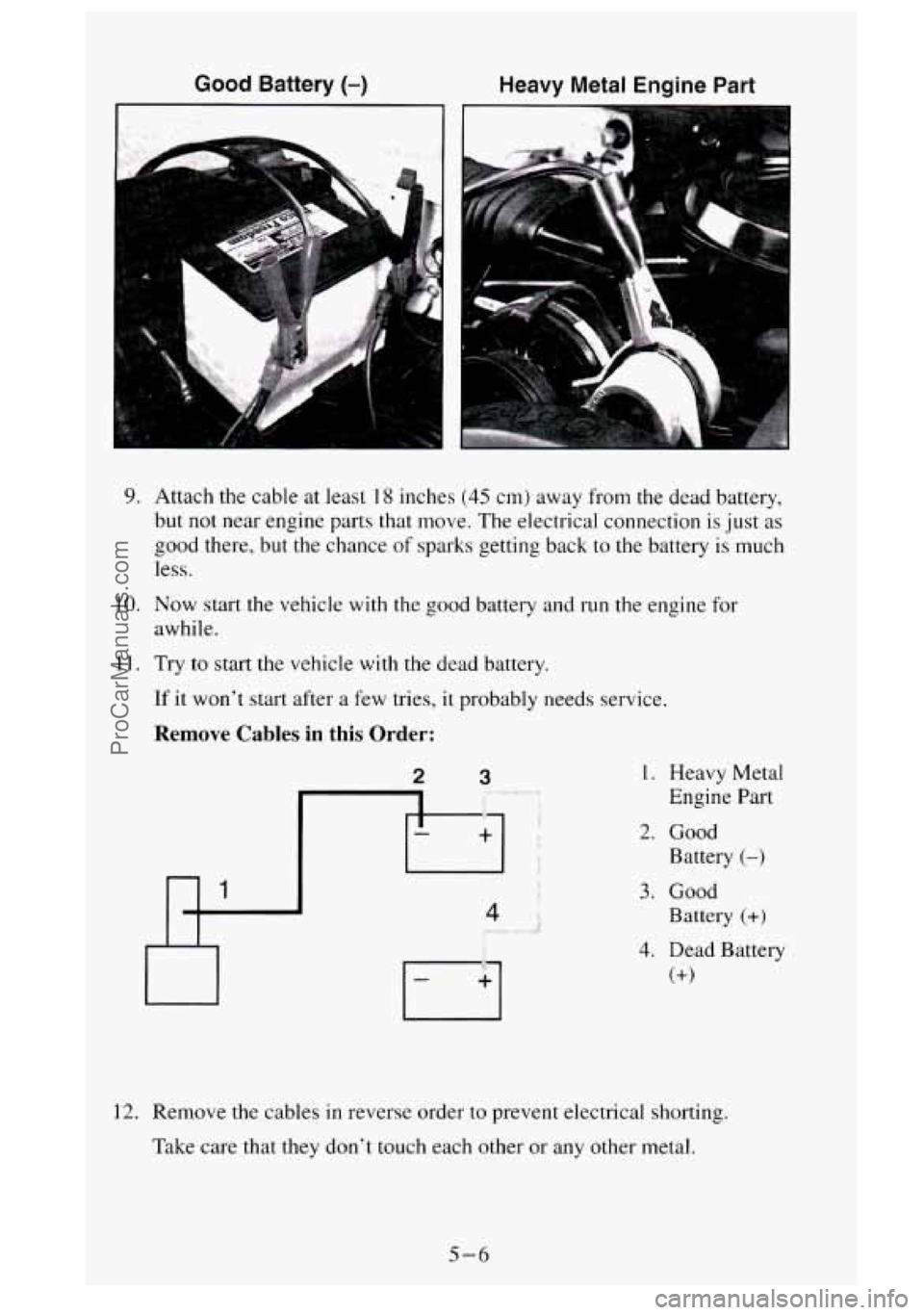
Good Battery (-)
9.
IO.
11.
Heavy Metal Engine
I
Part
3
1
Attach the cable at leas1 18 inches (45 cm) away from the dead battery,
but not near engine parts that move. The electrical connection is just as
good there, but the chance of sparks getting back to the battery is much
less.
Now start the vehicle with the good battery and run the engine for
awhile.
Try to start the vehicle
with the dead battery.
If it won’t start after a few tries, it probably needs service.
Remove Cables in this Order:
2
1
- +
4 .. .
1. Heavy Metal
Engine Part
2. Good Battery
(-)
3. Good
Battery
(+)
4. Dead Battery
(+>
12. Remove the cables in reverse order to prevent electrical shorting.
Take care that they don’t touch each other or any other metal.
5-6
ProCarManuals.com
Page 313 of 488
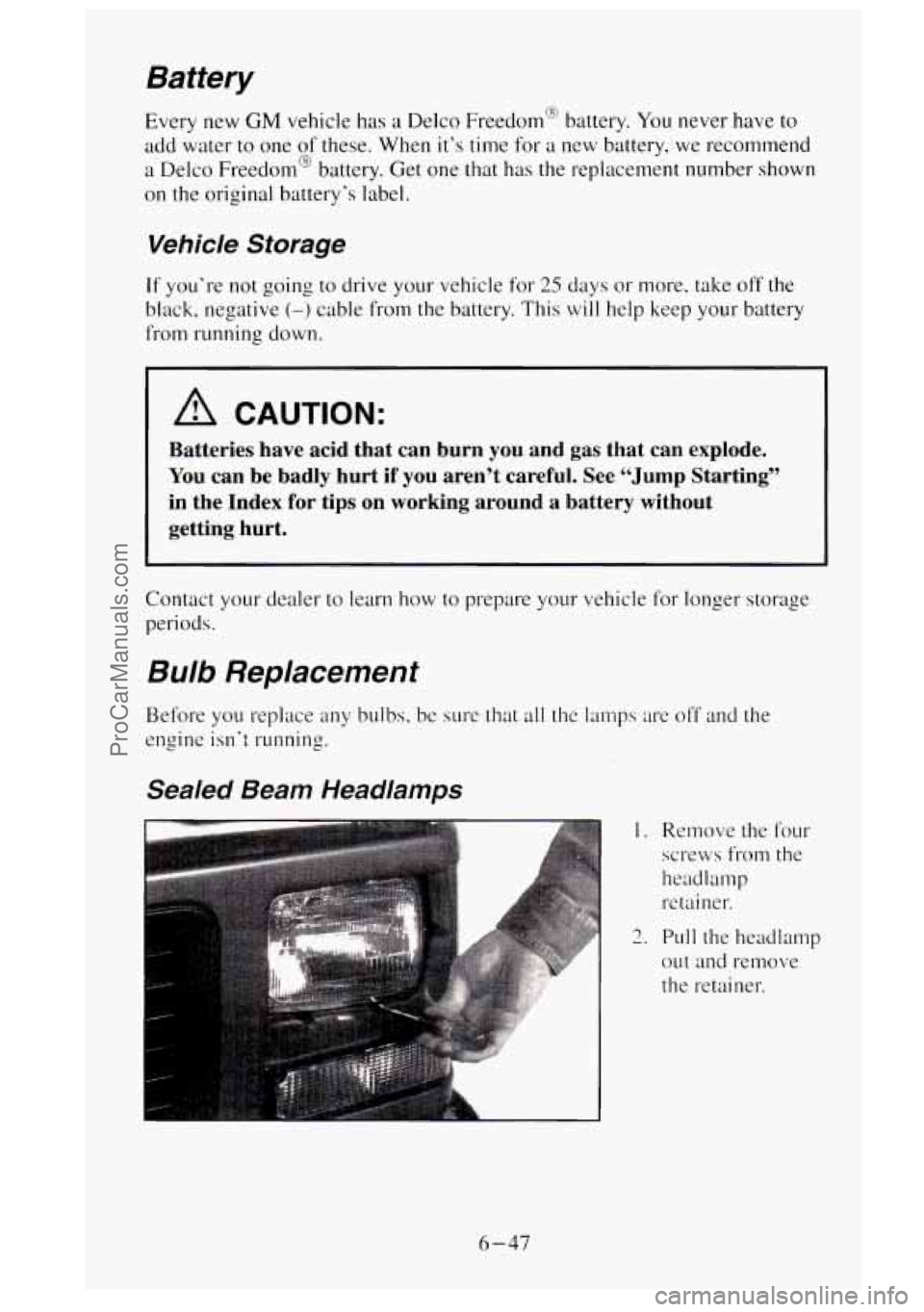
Battery
Every new GM vehicle has a Delco Freedom@ battery. You never have to
add water to one of these. When it’s time for a new battery, we recommend
a Delco Freedom@ battery. Get one that has the replacement number shown
on the original battery’s label.
Vehicle Storage
If you’re not going to drive your vehicle for 25 days or more. take off the
black, negative (-) cable from the battery. This will help keep your battery
from running down.
A CAUTION:
Batteries have acid that can burn you and gas that can explod\
e.
You can be badly hurt if you aren’t careful. See “Jump Start\
ing’’
in the Index for tips on working around a battery without
getting hurt.
Contact your dealer to learn how to prepare your vehicle for longer storage
periods.
Bulb Replacement
Before you replace any bulbs. be sure that all the lamps are off and the
engine isn’t running.
Sealed Beam Headlamps
I. Remove the four
screws from the
headlamp retainer.
2. Pull the headlamp
out and remove
the retainer.
6-47
ProCarManuals.com
Page 345 of 488

Fuses and Circuit Breakers
The wiring circuits in your vehicle are protected from short circuits by a
combination of fuses, circuit breakers, and fusible thermal links
in the
wiring itself. This greatly reduces
the chance of fires caused by electrical
problems. See “Fuses and Circuit Breakers’’
in the Index for more
information.
Headlamps
The headlamp wiring is protected by a circuit breaker in the lamp switch.
An electrical overload will cause
the lamps to flicker on and off, or in some
cases to remain
off. If this happens, have your headlamp wiring checked
right away.
Windshield Wipers
The windshield wiper motor is protected by a clrculc DreaKer ana a ruse. 11
the motor overheats due to heavy snow, etc., the wiper will stop until the
motor cools. Although the circuit is protected from electrical overload,
overload due to heavy snow, etc., may cause wiper linkage damage. Always
clear ice and heavy snow from the the windshield before using the
windshield wipers. If the overload
is caused by some electrical problem and
not snow, etc., be sure
to get it fixed.
Power Windows and Other Power Options
Circuit breakers in the fuse panel protect the power windows and other
power accessories. When the current load is too heavy, the circuit breaker
opens and closes. This protects the circuit
until the current load returns to
normal or the problem is fixed.
Trailer Wiring Harness
The standard seven-wire trailer wiring harness is protected by an in-line
fuse in the battery feed wire. This fuse is near the junction block. See
“Trailer Wiring Harness” in the Index for more information.
6-79
ProCarManuals.com
Page 465 of 488
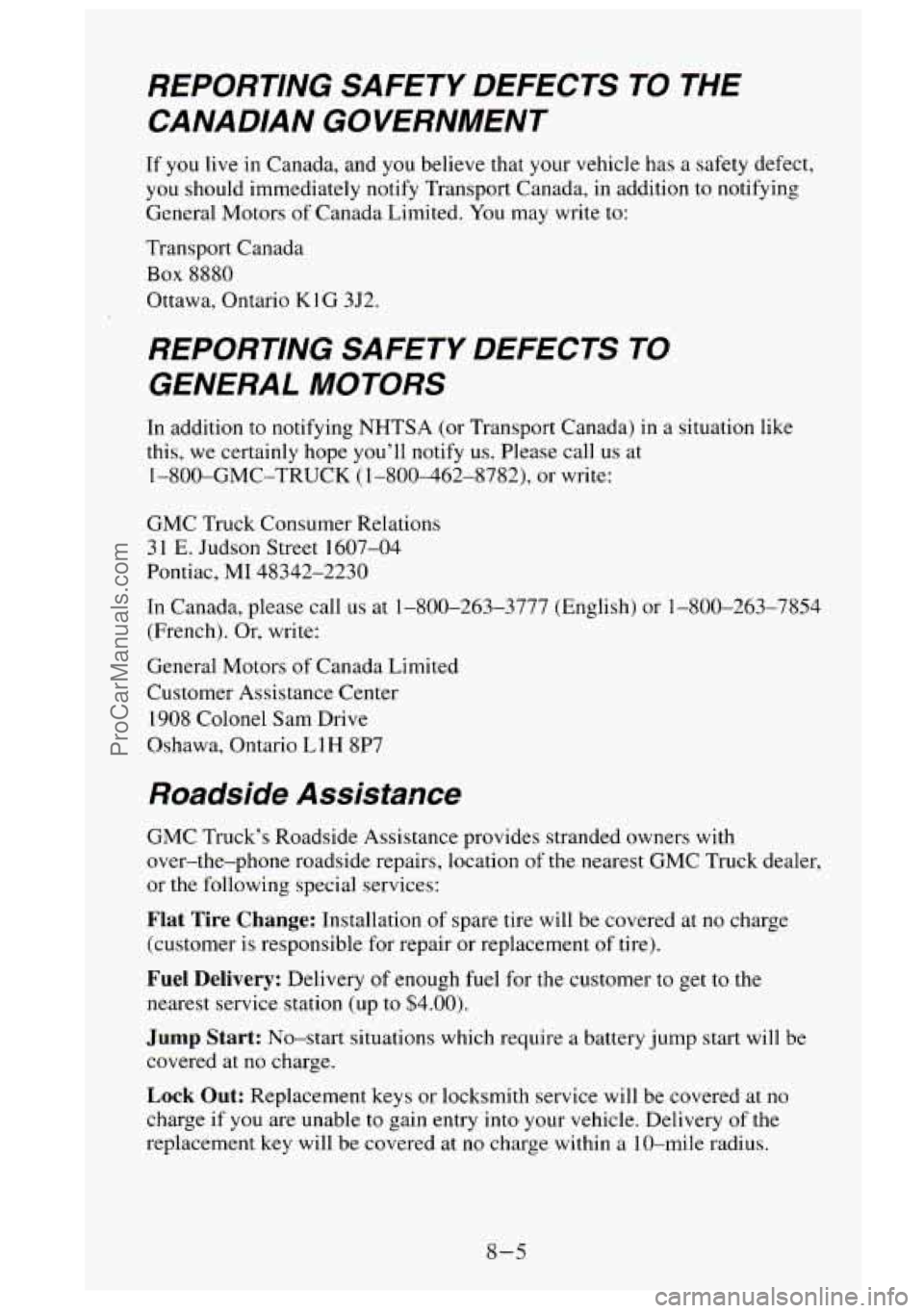
REPORTING SAFETY DEFECTS TO THE
CANADIAN GOVERNMENT
If you live in Canada, and you believe that your vehicle has a safety defect,
you should immediately notify Transport Canada, in addition
to notifying
General Motors of Canada Limited.
You may write to:
Transport Canada
Box 8880
Ottawa, Ontario K1 G 352.
REPORTING SAFETY DEFECTS TO GENERAL MOTORS
In addition to notifying NHTSA (or Transport Canada) in a situation like
this, we certainly hope
you’ll notify us. Please call us at
1-800-GMC-TRUCK (1-800-462-8782), or write:
GMC Truck Consumer Relations
3
1 E. Judson Street 1607-04
Pontiac, MI 48342-2230
In Canada, please call
us at 1-800-263-3777 (English) or 1-800-263-7854
(French). Or, write:
General Motors of Canada Limited
Customer Assistance Center
1908 Colonel Sam Drive
Oshawa, Ontario
LlH 8P7
Roadside Assistance
GMC Truck’s Roadside Assistance provides stranded owners with
over-the-phone roadside repairs, location of the nearest GMC Truck dealer,
or the following special services:
Flat Tire Change: Installation of spare tire will be covered at no charge
(customer
is responsible for repair or replacement of tire).
Fuel Delivery: Delivery of enough fuel for the customer to get to the
nearest service station (up to $4.00).
Jump Start: No-start situations which require a battery jump start will be
covered at
no charge.
Lock Out: Replacement keys or locksmith service will be covered at no
charge if you are unable to gain entry into your vehicle. Delivery of the
replacement key will be covered at no charge within a 10-mile radius.
8-5
ProCarManuals.com